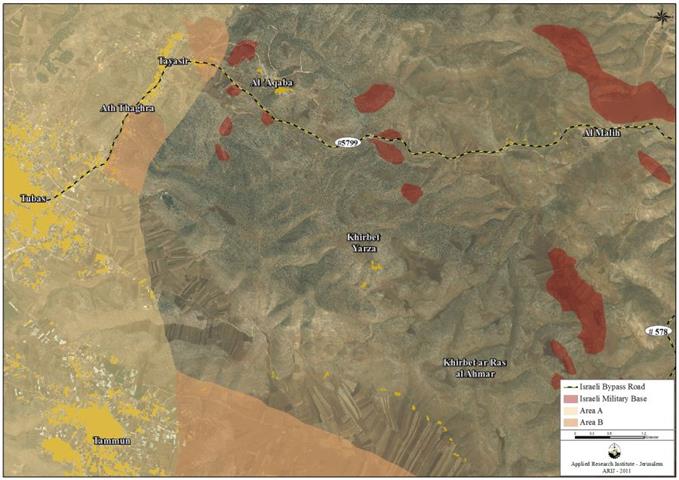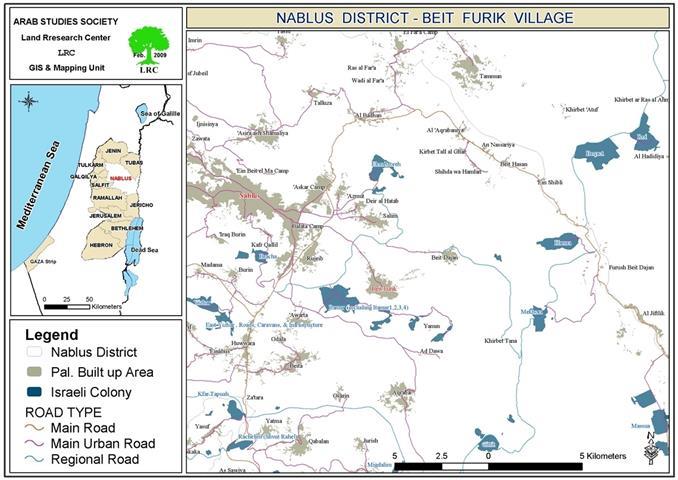On the 17th of February 2011, eight Israeli Occupation army jeeps accompanied bulldozers and demolished Palestinian structures in Kherbit Yerza (Yerza Hamlet) located to the east of Tubas city in the northern Valleys. The process included the demolition of Kherbit Yerza’s only Mosque and seven other barracks. The Israeli Occupation army also gave residents of Kherbit Yerza orders to demolish other houses and barracks in the coming days. Map 1
Map 1: Location of Yerza Hamlet
Table 1 includes details of the demolished structures in Kherbit Yerza:-
|
Table 1: Damages inflicted by the demolition process carried out by the Israeli Bulldozers
|
|
No.
|
Owner Name
|
No. of sheep
|
no. of Family members
|
Houses
|
Barracks
|
Toilets
|
Tabon
|
Other Damages
|
|
1
|
Na’im Hafez Ahmad Masa’id
|
124
|
6
|
0
|
2
|
1
|
1
|
Destruction of 5 Tons of Fodders |
|
2
|
Fawzi Mahmoud ‘Anbousi
|
200
|
8
|
0
|
2
|
0
|
0
|
The structure was demolished previously by the owner himself according to a previously issued military order |
|
3
|
Muhammad Mahmoud Ibrahim Daraghmah
|
120
|
4
|
0
|
2
|
1
|
0
|
|
|
4
|
Khaled Muhammad Mahmoud Daraghmah
|
150
|
8
|
0
|
2
|
0
|
0
|
The structure was demolished previously by the owner himself according to a previously issued military order |
|
5
|
Hafez Na’in Hafez Masa’id
|
86
|
4
|
0
|
1
|
1
|
1
|
|
|
6
|
Fayez Hamed Abed Daraghmah
|
60
|
4
|
0
|
1
|
0
|
0
|
He was delivered a military order to demolish his house and a barracks he owns |
|
7
|
Hasan Khaled Mahmoud Daraghmah
|
97
|
6
|
0
|
1
|
0
|
0
|
|
|
8
|
Mahmoud Fawzi Mahmoud ‘Anbousi
|
105
|
9
|
0
|
2
|
0
|
0
|
The structure has been demolished previously by the owner himself according to a previously issued military order
|
|
9
|
Amir Khaled Mahmoud Daraghmah
|
50
|
6
|
0
|
1
|
0
|
0
|
|
|
10
|
Sami Khaled Mahmoud
|
89
|
6
|
0
|
1
|
0
|
0
|
|
|
Total
|
1081
|
61
|
0
|
15
|
3
|
2
|
|
|
Source: ARIJ Field Team 2011
|
 Photo 1: A copy of one of the military orders that were given to residents of Yerza Hamlet
Photo 1: A copy of one of the military orders that were given to residents of Yerza Hamlet
Photo 2-7: The destruction in Yerza Hamlet in the northern Valleys
Furthermore, the Israeli occupation soldiers terrorized local residents of Kherbit Yerza, especially children, and attacked one of the journalists who was present at the site of demolition and confiscated other Journalists’ cameras and prevented them from covering the demolition. The Israeli soldiers also threatened to kill any resident who approaches the bulldozers on duty or even try to remove any of his possessions during the demolition, and asked residents to leave the area allegedly for being classified as a ‘closed military zone’.
Israeli occupation soldiers also insulted local residents of Kherbit Yerza and threatened that they would return again to demolish what remained after they delivered three other demolition orders to Palestinian families in the area and any other facilities to be built after the demolition is carried out by the occupation bulldozers. It is noteworthy that Israeli bulldozers had demolished on 25th of November 2011 the only mosque in the hamlet, two houses and 13 other barrackses used as fodder stores and animal barns.
One day after the demolition took place in Kherbit Yerza in the northern valleys ( on the 18th of February of 2011), six Israeli vehicles carrying settlers raided Yerza hamlet and toured around and started asking many questions about the nature of the hamlet and the names of the surrounding areas. Local residents reported that these are rare cases when Israeli settlers enter the hamlet due to its location far from Israeli settlements in the area and that the area where Kherbit Tana is located, is classified by the Israelis as ‘closed military zone’ where Israeli occupation forces use it for their extensive military trainings.
The Israeli Demolition Policy in International Law
The
right to adequate housing is a basic human
right and essential to the fulfillment of a civilized and decent life and has been recognized in article 11 of the International Covenant on Economic, Social and Cultural Rights: ‘ The States Parties to present Covenant recognize the right of everyone to an adequate standard of living for himself and his family, including adequate food, clothing and housing, and to the continuous improvement of living conditions. The States Parties will take appropriate steps to ensure the international co-operation based on free consent.
The Israeli policy of destroying Palestinian houses and properties in the occupied Palestinian Territory started back in 1967 when Israel occupied the Palestinian territory and the scale of destruction has reached an unprecedented level over the years; thus contradicting all treaties, International Law and International Conventions, such as:-
-
According to Article 53 of the Fourth Geneva Convention states that: ‘Any destruction by the Occupying Power of real or personal property belonging individually or collectively to private persons, or to the State, or to other public authorities, or to social or cooperative organizations, is prohibited, except where such destruction is rendered absolutely necessary by military operations
.’
-
Article 23(g) of the 1907 Hague Regulations states that it is especially forbidden ‘To destroy or seize the enemy’s property, unless such destruction or seizure be imperatively demanded by the necessities of war;
‘
-
Article 33 of the Fourth Geneva Convention stipulates that: ‘No protected person may be punished for an offence he or she has not personally committed. Collective penalties and likewise all measures of intimidation or of terrorism are prohibited.’ … ‘Pillage is prohibited.’ … ‘Reprisals against protected persons and their property are prohibited.
:::::::::::::::_
Prepared by:





















